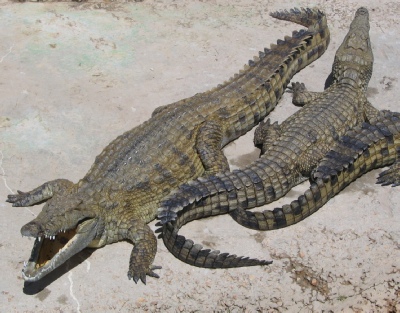



Unique Reptile Parties and Shows
Snakes, Lizards, Giant Tortoises and Crocs
07792491044

NILE CROCODILE
 The Nile crocodile or common crocodile (Crocodylus niloticus) is an African crocodile
which is common in Somalia, Ethiopia, Uganda, Kenya, Egypt, Tanzania, Zambia, Zimbabwe,
Gabon, South Africa, Malawi, Sudan, South Sudan, Botswana, and Cameroon. Isolated
populations also exist in Madagascar and in Senegal
The Nile crocodile or common crocodile (Crocodylus niloticus) is an African crocodile
which is common in Somalia, Ethiopia, Uganda, Kenya, Egypt, Tanzania, Zambia, Zimbabwe,
Gabon, South Africa, Malawi, Sudan, South Sudan, Botswana, and Cameroon. Isolated
populations also exist in Madagascar and in Senegal
In antiquity, Nile crocodiles occurred in the Nile Delta and the Zarqa River (Jordan), and they are recorded by Herodotus to have inhabited Lake Moeris. They are thought to have become extinct in the Seychelles in the early 19th century. They are known from fossil remains to have once inhabited Lake Edward. The Nile crocodile's current range of distribution extends from the Senegal River, Lake Chad, Wadai and the Sudan to the Cunene and the Okavango Delta. In Madagascar, crocodiles occur in the western and southern parts from Sembirano to Port Dauphin. They have occasionally been spotted in Zanzibar and the Comoros. Until recently, many permanent waters in the Sahara still housed relict populations.
In East Africa, they are found mostly in rivers, lakes, marshes, and dams. They have been known to enter the sea in some areas, with one specimen having been seen 11 kilometres (6.8 mi) off St Lucia Bay in 1917. In Madagascar, they have adapted to living in caves.
The species was previously thought to extend into West Africa, but these populations are now recognized as a distinct species, the desert crocodile.
Nile crocodiles have a dark bronze colouration above, with black spots on the back and a dirty purple on the belly. The flanks, which are yellowish-green in colour, have dark patches arranged in oblique stripes. There is some variation relative to environment; specimens from swift-flowing waters tend to be lighter in colour than those dwelling in lakes or swamps. They have green eyes.
Like all crocodiles, the Nile crocodile is a quadruped with four short, splayed legs, a long, powerful tail, a scaly hide with rows of ossified scutes running down its back and tail, and powerful jaws. It has nictitating membranes to protect the eyes and lachrymal glands to cleanse its eyes with tears. The nostrils, eyes, and ears are situated on the top of the head, so the rest of the body can remain concealed underwater. The coloration also helps to camouflage it, juveniles are grey, multicoloured, or brown, with dark cross-bands on the tail and body. As it matures, it becomes darker and the cross-bands fade, especially those on the body. The underbelly is yellowish green, and makes high-quality leather.
They normally crawl along on their bellies, but they can also "high walk" with their trunks raised above the ground. Smaller specimens can gallop, and even larger crocodiles are capable of surprising bursts of speeds, briefly reaching up to 12 to 14 km/h (7.5 to 8.7 mph). They can swim much faster by moving their bodies and tails in a sinuous fashion, and they can sustain this form of movement much longer at about 30 to 35 km/h (19 to 22 mph).
They have a four-chambered heart, although modified for their ectothermic nature due to an elongated cardiac septum, physiologically similar to the heart of a bird, which is especially efficient at oxygenating their blood. They normally dive for only a few minutes, but will stay underwater for up to 30 minutes if threatened, and if they remain inactive they can hold their breath for up to two hours. They have an ectothermic metabolism, so can survive for long periods between meals — though when they do eat, they can eat up to half their body weight at a time.
They have a rich vocal range, and good hearing. Their skin has a number of poorly understood integumentary sense organs (ISOs) that may react to changes in water pressure.
The bite force exerted by an adult Nile crocodile has been shown by Dr. Brady Barr to measure 5,000 lbf (22 kN). However, the muscles responsible for opening the mouth are exceptionally weak, allowing a man to easily hold them shut with a small amount of force. Their mouths are filled with a total of 64 to 68 cone-shaped teeth. On each side of the mouth, there are five teeth in the front of the upper jaw (premaxilla), 13 or 14 in the rest of the upper jaw (maxilla), and 14 or 15 on either side of the lower jaw (mandible). Hatchlings quickly lose a hardened piece of skin on the top of their mouths called the egg tooth, which they use to break through their eggshells at birth.
Outside water, crocodiles can meet competition from other dominant savanna predators, notably felines such as lions and leopards. Occasionally, both the big cats and the crocodile will hunt and prey on each other, depending on size, if regular food becomes scarce.
Healthy mid-sized adult
The Nile crocodile is the largest crocodilian in Africa and is sometimes regarded as the second-largest crocodilian after the saltwater crocodile. The male crocodile usually measure from 3.5 to 5 metres (11 to 16 ft) long, but very old, mature ones can grow to 5.5 m (18 ft) or more. Like all crocodiles they are sexually dimorphic, with the males up to 30% larger than the females, though the difference is even more in some species, like the saltwater crocodile. Mature female Nile crocodiles measure 2.4 to 4 m (7 ft 10 in to 13 ft 1 in). Typical Nile crocodile weight is from 225 to 500 kg (500 to 1,100 lb), though large males can range up to 750 kg (1,700 lb) in mass. The largest accurately measured male, shot near Mwanza, Tanzania, measured 6.45 m (21.2 ft) and weighed about 1,090 kg (2,400 lb).
Seven-meter specimens and larger have been reported, but since gross overestimation of size is common, these reports are suspect. The largest living specimen is purported to be a man-eater from Burundi named Gustave; he is believed to be more than 6.1 m (20 ft) long. Such giants are rare today; before the heavy hunting of the 1940s and 1950s, a larger population base and more extensive wetland habitats meant more giants.
Evidence exists of Nile crocodiles from cooler climates like the southern tip of Africa being smaller, and may reach lengths of only 4 m (13 ft). Dwarf Nile crocodiles also exist in Mali and in the Sahara Desert, which reach only 2 to 3 m (6 ft 7 in to 9 ft 10 in) in length. Their reduced size is probably the result of the less than ideal environmental conditions, not genetics.
The Nile crocodile possesses unique predation behavior characterized by the ability of preying both within its natural habitat (where it is the apex predator) and out of its normal range, which often results in unpredicted attacks on almost any other animal equal or smaller in size. In the water, where the only possible threat it can meet are species of its own kind, as well as adult hippos, it is an agile and rapid hunter relying on both movement and pressure sensors to catch any prey unfortunate enough to present itself inside or near the waterfront. Out of water, however, the Nile crocodile can only rely on its limbs (as it gallops on solid ground) to chase the prey. Most hunting on land is done at night by lying in ambush near forest trails or roadsides, up to 50 m (170 feet) from the water's edge.
Young hatchlings generally feed on smaller prey, preferring insects and small aquatic invertebrates before taking on fish, amphibians and small reptiles. Juveniles and subadults take a wider variety of prey with additions such as birds and small to mid-sized mammals. Throughout their lives, both young and mature crocodiles can feed on fish and other small vertebrates on separate occasions, when large food is absent, as a side diet. Adults are apex predators and prey upon various birds, reptiles and mammals, in addition to prey consumed also by the young and juvenile specimens. Among the mammals, prey consists of gazelles, antelope, waterbuck, wildebeest, zebras, warthogs, young hippos, giraffes, Cape buffalos, and young elephants. When given the chance, they are known to prey on domestic chickens, goats, sheep and cattle. Nile crocodiles also prey on humans frequently, far more often than other crocodilian species (although in parts of the Philippines and New Guinea, saltwater crocodile attacks can also be common). Although not common, crocodiles can also hunt in packs of five or more individuals while in the water, which can lead to the capture of much larger prey such as hippopotamus and even the black rhinoceros.
Adult Nile crocodiles use their bodies and tails to herd groups of fish toward a bank, and eat them with quick sideways jerks of their heads. They also cooperate, blocking migrating fish by forming a semicircle across the river. The most dominant crocodile eats first. Their ability to lie concealed with most of their bodies underwater, combined with their speed over short distances, makes them effective opportunistic hunters of larger prey. They grab such prey in their powerful jaws, drag it into the water, and hold it underneath until it drowns. They will also scavenge kills, although they avoid rotting meat. Groups of Nile crocodiles may travel hundreds of metres from a waterway to feast on a carcass. Once their prey is dead, they rip off and swallow chunks of flesh. When groups are sharing a kill, they use each other for leverage, biting down hard and then twisting their bodies to tear off large pieces of meat in a "death roll". They may also get the necessary leverage by lodging their prey under branches or stones, before rolling and ripping.
Herodotus claimed Nile crocodiles have a symbiotic relationship with certain birds, such as the Egyptian plover, which enter the crocodile's mouth and pick leeches feeding on the crocodile's blood, but there is no evidence of this interaction actually occurring in any crocodile species, and it is most likely mythical or allegorical fiction.
For males, the onset of sexual maturity occurs when they are about 3 metres (9.8 ft) long, while for females, it occurs when they reach 2 to 2.5 metres (6 ft 7 in to 8 ft 2 in) in length. This takes about 10 years for either sex, under normal conditions.
During the mating season, males attract females by bellowing, slapping their snouts in the water, blowing water out of their noses, and making a variety of other noises. The larger males of a population tend to be more successful. Once a female has been attracted, the pair warble and rub the undersides of their jaws together. Females lay their eggs about two months after mating.
Nesting is in November or December, which is the dry season in the north of Africa, and the rainy season in the south. Preferred nesting locations are sandy shores, dry stream beds, or riverbanks. The female then digs a hole a few metres from the bank and up to 500 mm (20 in) deep, and lays between 25 and 80 eggs. The number of eggs varies between different populations, but averages around 50. Multiple females may nest close together.
The eggs resemble hen eggs, but have a much thinner shell.
Unlike most other crocodilians, female Nile crocodiles will bury their eggs in sand rather than incubate them in rotting vegetation. After burying the eggs, the female then guards them for the three-month incubation period. The sire will often stay nearby, and both parents will fiercely attack anything approaching their eggs. The female will only leave the nest if she needs to cool off (thermoregulation), by taking a quick dip or seeking out a patch of shade. Despite the attentive care of both parents, the nests are often raided by humans, monitor lizards, and other animals while she is temporarily absent.
The hatchlings start to make a high-pitched chirping noise before hatching, which is the signal for the mother to rip open the nest. Both the parents may pick up the eggs in their mouths, and roll them between their tongue and the upper palate to help crack the shell, and release their offspring. Once they are hatched, the female may lead the hatchlings to water, or even carry them there, in her mouth.
Nile crocodiles have (TSD) temperature-dependent sex determination, which means the sex of their hatchlings is determined not by genetics, but by the average temperature during the middle third of their incubation period. If the temperature inside the nest is below 31.7°C (89.1°F), or above 34.5°C (94.1°F), the offspring will be female. Males can only be born if the temperature is within that narrow five-degree range.
Hatchlings are about 300 mm (12 in) long at birth, and grow that much each year. The new mother will protect her offspring for up to two years, and if there are multiple nests in the same area, the mothers may form a crèche. During this time, the mothers may pick up their offspring to protect them, either in their mouths or gular fold (throat pouch), to keep the babies safe. The mother will sometimes carry her young on her back to avoid them getting eaten by turtles or water snakes. At the end of the two years, the hatchlings will be about 1.2 m (4 ft) long, and will naturally depart the nest area, avoiding the territories of older and larger crocodiles.
Crocodile longevity is not well established, but larger species like the Nile crocodile live longer, and may have an average life span of 70–100 years
This species is farmed for its meat and leather in some parts of Africa
From the 1940s to the 1960s, the Nile crocodile was hunted, primarily for high-quality leather, though also for meat with its purported curative properties. The population was severely depleted, and the species faced extinction. National laws, and international trade regulations have resulted in a resurgence in many areas, and the species as a whole is no longer threatened with extinction. Crocodile 'protection programs' are artificial environments where crocodiles exist safely and without the threat of extermination from hunters.
An estimated 250,000 to 500,000 individuals occur in the wild. The Nile crocodile is also widely distributed, with strong, documented populations in many countries in eastern and southern Africa, including Somalia, Ethiopia, Kenya, Zambia and Zimbabwe. Successful sustainable-yield programs focused on ranching crocodiles for their skins have been successfully implemented in this area, and even countries with quotas are moving toward ranching. In 1993, 80,000 Nile crocodile skins were produced, the majority from ranches in Zimbabwe and South Africa.
The situation is more grim in central and west Africa, which make up about two-thirds of the Nile crocodile's habitat. The crocodile population in this area is much more sparse, and has not been adequately surveyed. While the natural population in these areas may be lower due to a less-than-ideal environment and competition with sympatric slender-snouted and dwarf crocodiles, extirpation may be a serious threat in some of these areas. Additional factors are a loss of wetland habitats, and hunting in the 1970s. Additional ecological surveys and establishing management programs are necessary to resolve this.
The Nile crocodile is the top predator in its environment, and is responsible for checking the population of species such as the barbel catfish, a predator that can overeat fish populations on which other species, like birds, depend. The Nile crocodile also consumes dead animals that would otherwise pollute the waters. The main threats to them, in turn, are pollution, loss of habitat, hunting, and human activities such as accidental entanglement in fishing nets.
Much of the hunting stems from their reputation as a man-eater, which is not entirely unjustified. Unlike other "man-eating" crocodiles, such as the saltwater crocodile, the Nile crocodile lives in close proximity to human populations, so contact is more frequent. Although most attacks do not get reported, the Nile crocodile is estimated to kill hundreds (possibly thousands) of people each year, which is more than all other crocodilian species combined. One study posited the number of attacks by Nile crocodiles per year as 275 to 745, of which 63% are fatal, as opposed to an estimated 30 attacks per year by saltwater crocodiles, of which 50% are fatal. In both species, the mean size of crocodiles involved in nonfatal attacks was about 3 m (9.8 ft) as opposed to a reported range of 2.5–5 m (8.2–16 ft) or larger for crocodiles responsible for fatal attacks. Since a majority of fatal attacks are believed to be predatory in nature, the Nile crocodile can be considered the most prolific predator of humans among wild animals.
The IUCN Red List assesses the Nile crocodile as "Least Concern (LR/lc)". The CITES lists the Nile crocodile under Appendix I (threatened with extinction) in most of its range; and under Appendix II (not threatened, but trade must be controlled) in the remainder, which either allows ranching or sets an annual quota of skins taken from the wild.
Suitable leafy green vegetables include collard greens, spring greens, cabbage, carrot tops parsley and Dragons may also eat orange-fleshed, green, yellow, squashes, peppers, zuchinni, carnations and rose petals. Suitable fruits are strawberries, melons, mangoes. Insects captured in the wild are not recommended, due to the increased risk of infection or disease